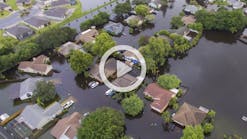This spring, Penn State, a leader in green-roof research, will plant vegetation on two large green roofs that were prepared last fall, according to Penn State Live. One of the green roofs will be what lead researcher Rob Berghage calls a “showcase” on top of the university’s recently opened $30.5 million Forest Resources Building.
The green roof was a key factor in the structure recently receiving a Leadership in Energy and Environmental Design (LEED) Silver Certification by the U.S. Green Building Council, a designation officials in the university’s College of Agricultural Sciences point to as proof that they are serious about developing sustainable buildings that are more energy efficient, water efficient and ecologically sound.
“Since our academic unit is based upon the principles of sustaining natural resources, we are aptly proud of the LEED Silver Certification earned by our new home,” said Chuck Strauss, director of the School of Forest Resources.
A special feature of the green roof on the Forest Resources Building, according to Strauss, is a large viewing deck built with a composite wood-plastic material developed by a researcher in the school. “Once the plants are growing on the roof and the weather gets nice, that deck will be a popular place for students, faculty and staff to have lunch and relax,” Strauss predicted.
What makes the green roof “green” is the dense covering of plants and groundcover-like vegetation placed on top of the building, explained Berghage, associate professor of horticulture. “Typically a flat roof works best,” he said. “To have a green roof, a building must be designed to support the extra weight of the vegetation, 4 to 12 in. of planting medium, a roof membrane and a drainage layer.”
Those preparations were completed last fall on the 4,700-sq-ft roof over part of the Forest Resources Building, and on the 4,500-sq-ft roof over a root cellar near the greenhouses behind Tyson Building off Eisenhower Boulevard. Runoff from the green roof over the root cellar will be collected and piped to a basin where students in Berghage’s Eco-Roof Technology horticulture class can monitor the water quantity and quality, as well as plant growth and effectiveness of the green roof.
“This monitoring will be part of our research, and it will go on for long time,” Berghage said. “Penn State has been doing green roof research longer than any other institution in North America.”
The large, shallow-media “extensive” zones of the roofs will be planted with a variety of sedum species and other drought-tolerant plants such as allium and talinum, while the deeper “intensive” parts of the roof will have larger showy herbaceous perennials such as salvia and lavender.
Green roofs offer a number of benefits, Berghage explained. “Many older cities have sewage-treatment problems, and their sewage systems often overflow with storm water,” he said. “Green roofs absorb and hold some of that water. Every drop of water that hits a roof must go somewhere, and usually that place is a storm water basin. Not only do we lose valuable land by setting it aside for storm water retention basins, but they become an eyesore and a breeding ground for mosquitoes, which may carry West Nile Virus. Green roofs address these issues.”
In addition, the insulation provided by the vegetation can reduce the energy needed to cool or heat a building by 10% or more, Berghage pointed out.
Yet, with all the positives, Berghage noted that green roofs can be difficult to implement. “You generally run into problems in terms of weight,” he said. “The cost of reinforcing an existing roof may not justify it, so most green roofs these days are constructed on new buildings such as the Forest Resources Building.”
Green roofs have been popular in Europe for decades but have been slow to catch on in the U.S. However, the move toward constructing green roofs in this country seems to be gaining momentum, according to Berghage. “We are beginning to see a shift toward more green roofs in places like Chicago to counteract problems with heat in buildings,” he said. “In fact, from last year to this year, there has been an 80% increase in green roof projects.”
Source: Penn State Live






